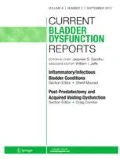Abstract
This paper reports on the currently available information regarding urethral dysfunction as presented during the scientific session of the 2006 Society for Urodynamics and Female Urology meeting in Atlanta, GA. Anatomic studies of the urethral sphincter complex contribute to our understanding of the continence mechanism, particularly as it relates to sex differences and the effect of androgens. It is important to understand biomechanical concepts of load and stress as they relate to the demonstration of incontinence on urodynamic studies. Urethral imaging complements our ability to accurately diagnose clinical problems. The pharmacologic components of urethral pressure are also discussed. Continued advances in our understanding of urethral dysfunction will guide improved diagnosis and treatment of these disorders.
Similar content being viewed by others
References and Recommended Reading
Yucel S, Baskin LS: An anatomical description of the male and female urethral sphincter complex. J Urol 2004, 171:1890–1897.
Borirakchanyavat S, Baskin LS, Kogan BA, Cunha GR: Smooth and striated muscle development in the intrinsic urethral sphincter. J Urol 1997, 158(3 Pt 2):1119–1122.
Masata J, Svabik K, Martan A, et al.: What ultrasound parameter is optimal in the examination of position and mobility of urethrovesical junction? Ceska Gynekol 2005, 70:280–285.
Schäfer W: Some biomechanical aspects of continence function. Scand J Urol Nephrol Suppl 2001, 207:44–60; discussion 106–125.
Lose G, Griffiths D, Hosker G, et al.: Standardisation of urethral pressure measurement: report from the Standardisation Sub-Committee of the International Continence Society. Neurourol Urodyn 2002, 21:258–260.
Kim SH, Kim SH, Park BK, et al.: CT voiding cystourethrography using 16-MDCT for the evaluation of female urethral diverticula: initial experience. AJR Am J Roentgenol 2005, 184:1594–1596.
Umek WH, Obermair A, Stutterecker D, et al.: Three-dimensional ultrasound of the female urethra: comparing transvaginal and transrectal scanning. Ultrasound Obstet Gynecol 2001, 17:425–430.
Blander DS, Rovner ES, Schnall MD, et al.: Endoluminal magnetic resonance imaging in the evaluation of urethral diverticula in women. Urology 2001, 57:660–665.
Golomb J, Leibovitch I, Mor Y, et al.: Comparison of voiding cystourethrography and double-balloon urethrography in the diagnosis of complex female urethral diverticula. Eur Radiol 2003, 13:536–542.
Kondo Y, Homma Y, Takahashi S, et al.: Transvaginal ultrasound of urethral sphincter at the midurethra in continent and incontinent women. J Urol 2001, 165:149–152.
Tanagho EA: The anatomy and physiology of micturition. Clin Obstet Gynaecol 1978, 5:3–26.
Tanagho EA, Meyers FH, Smith DR: Urethral resistance: its components and implications: I. Smooth muscle component. Invest Urol 1969, 7:136–149.
Tanagho EA, Meyers FH, Smith DR: Urethral resistance: its components and implications: II. Striated muscle component. Invest Urol 1969, 7:195–205.
Donker PJ, Ivanovici F, Noach EL: Analyses of the urethra pressure profile by means of electromyography and the administration of drugs. Br J Urol 1972, 44:180–193.
Raz S, Caine M, Zeigler M: The vascular component in the production of intraurethral pressure. J Urol 1972, 108:93–96.
Awad SA, Downie JW: Relative contribution of smooth and striated muscles to the canine urethral pressure profile. Br J Urol 1976, 48:347–354.
Koff SA: Striated muscle determinants of intraurethral resistance. Invest Urol 1977, 15:147–148.
Rud T, Andersson KE, Asmussen M, et al.: Factors maintaining the urethral pressure in women. Invest Urol 1980, 17:343–347.
Rossier A, Fam B, Lee I, et al.: Role of striated and smooth muscle components in the urethral pressure profile in traumatic neurogenic bladders: a neuropharmacologic and urodynamic study. Preliminary report. J Urol 1982, 128:529–535.
Wein AJ, Barrett DM: Important functional questions. In Voiding Function and Dysfunction: A Logical and Practical Approach. London and Boca Raton: Year Book Publishers; 1988:109–136.
Andersson KE, Wein AJ: Pharmacology of the lower urinary tract: basis for current and future treatments of urinary incontinence. Pharmacol Rev 2004, 56:581–631.
Yoshimura N, Chancellor MB: Physiology and pharmacology of the urethra and bladder. In Campbell-Walsh Urology, edn 9. Edited by Wein AJ, Kavoussi LR, Novick AC, et al. Philadelphia: Elsevier; 2007:1922–1972.
Chang S, Hypolite JA, Zderic SA, et al.: Enhanced force generation by corpus cavernosum smooth muscle in rabbits with partial bladder outlet obstruction. J Urol 2002, 167:2636–2644.
Anderson KEA, Wein AJ: Pharmacologic management of storage and emptying failure. In Campbell-Walsh Urology, edn 9. Edited by Wein AJ, Kavoussi LR, Novick AC, et al. Philadelphia: Elsevier; 2007:2091–2127.
Taki N, Taniguchi T, Okada K, et al.: Evidence for predominant mediation of alpha1-adrenoceptor in the tonus of entire urethra of women. J Urol 1999, 162:1829–1832.
Su X, Stein R, Stanton MC, et al.: Effect of partial outlet obstruction on rabbit urinary bladder smooth muscle function. Am J Physiol Renal Physiol 2003, 284:F644–F652.
Ishiko O, Ushiroyama T, Saji F, et al.: Beta(2)-adrenergic agonists and pelvic floor exercises for female stress incontinence. Int J Gynaecol Obstet 2000, 71:39–44.
Author information
Authors and Affiliations
Corresponding author
Rights and permissions
About this article
Cite this article
Lee, U., Baskin, L., Schaefer, W. et al. Highlights of the Urethral Dysfunction sessions at the Society for Urodynamics and Female Urology. Curr Bladder Dysfunct Rep 2, 71–76 (2007). https://doi.org/10.1007/s11884-007-0003-2
Published:
Issue Date:
DOI: https://doi.org/10.1007/s11884-007-0003-2




